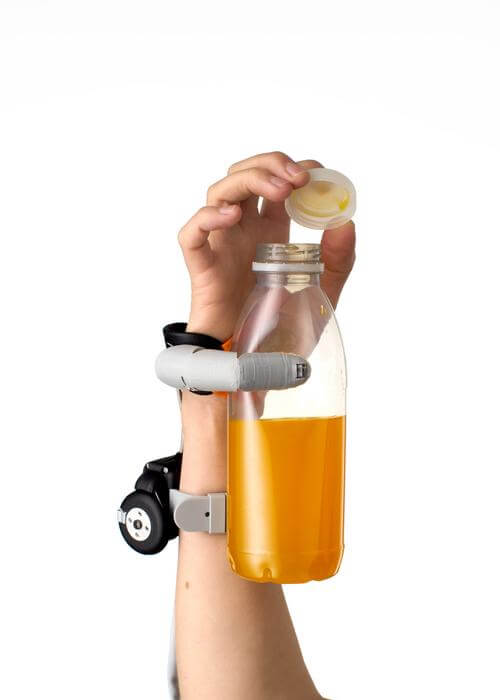
The Third Thumb worn by different users (CREDIT: Dani Clode Design / The Plasticity Lab)
CAMBRIDGE, United Kingdom — Will human evolution eventually give us a sixth finger? If it does, a new study is showing that we'll have no trouble using an extra thumb! It may sound like science fiction, but researchers have shown that people of all ages can quickly learn how to use an extra, robotic third thumb.
The findings, in a nutshell
A team at the University of Cambridge developed a wearable, prosthetic thumb device and had nearly 600 people from diverse backgrounds try it out. The results in the journal Science Robotics were astonishing: 98% of participants could manipulate objects using the third thumb within just one minute of picking it up and getting brief instructions.
The researchers put people through simple tasks like moving pegs from a board into a basket using only the robotic thumb. They also had people use the device along with their real hand to manipulate oddly-shaped foam objects, testing hand-eye coordination. People, both young and old, performed similarly well on the tasks after just a little practice. This suggests we may be surprisingly adept at integrating robotic extensions into our sense of body movement and control.
While you might expect those with hand-intensive jobs or hobbies to excel, that wasn't really the case. Most everyone caught on quickly, regardless of gender, handedness, age, or experience with manual labor. The only groups that did noticeably worse were the very youngest children under age 10 and the oldest seniors. Even so, the vast majority in those age brackets still managed to use the third thumb effectively with just brief training.
Professor Tamar Makin and designer Dani Clode have been working on Third Thumb for several years. One of their initial tests in 2021 demonstrated that the 3D-printed prosthetic thumb could be a helpful extension of the human hand. In a test with 20 volunteers, it even helped participants complete tasks while blindfolded!

How did scientists test the third thumb?
For their inclusive study, the Cambridge team recruited a wide range of 596 participants between the ages of three and 96. The group comprised an intentionally diverse mix of demographics to ensure the robotic device could be effectively used by all types of people.
The Third Thumb device itself consists of a rigid, controllable robotic digit worn on the opposite side of the hand from the normal thumb. It's operated by foot sensors - pressing with the right foot pulls the robotic thumb inward across the palm while the left foot pushes it back out toward the fingertips. Releasing foot pressure returns the thumb to its resting position.
During testing at a science exhibition, each participant received up to one minute of instructions on how to control the device and perform one of two simple manual tasks. The first had them individually pick up pegs from a board using just the third thumb and drop as many as possible into a basket within 60 seconds. The second required them to manipulate a set of irregularly-shaped foam objects using the robotic thumb in conjunction with their real hand and fingers.
Detailed data was collected on every participant's age, gender, handedness, and even occupations or hobbies that could point to exceptional manual dexterity skills. This allowed the researchers to analyze how user traits and backgrounds affected performance with the third thumb device after just a minute's practice. The stark consistency across demographics proved its intuitive usability.

What do researchers say?
“Technology is changing our very definition of what it means to be human, with machines increasingly becoming a part of our everyday lives, and even our minds and bodies,” says Prof. Makin, a member of the Medical Research Council (MRC) Cognition and Brain Sciences Unit at the University of Cambridge, in a media release. “These technologies open up exciting new opportunities that can benefit society, but it’s vital that we consider how they can help all people equally, especially marginalized communities who are often excluded from innovation research and development.”
“Augmentation is about designing a new relationship with technology—creating something that extends beyond being merely a tool to becoming an extension of the body itself. Given the diversity of bodies, it's crucial that the design stage of wearable technology is as inclusive as possible. It's equally important that these devices are accessible and functional for a wide range of users. Additionally, they should be easy for people to learn and use quickly,” adds Clode.
This research received funding from the European Research Council, Wellcome, the Medical Research Council, and Engineering and Physical Sciences Research Council.










